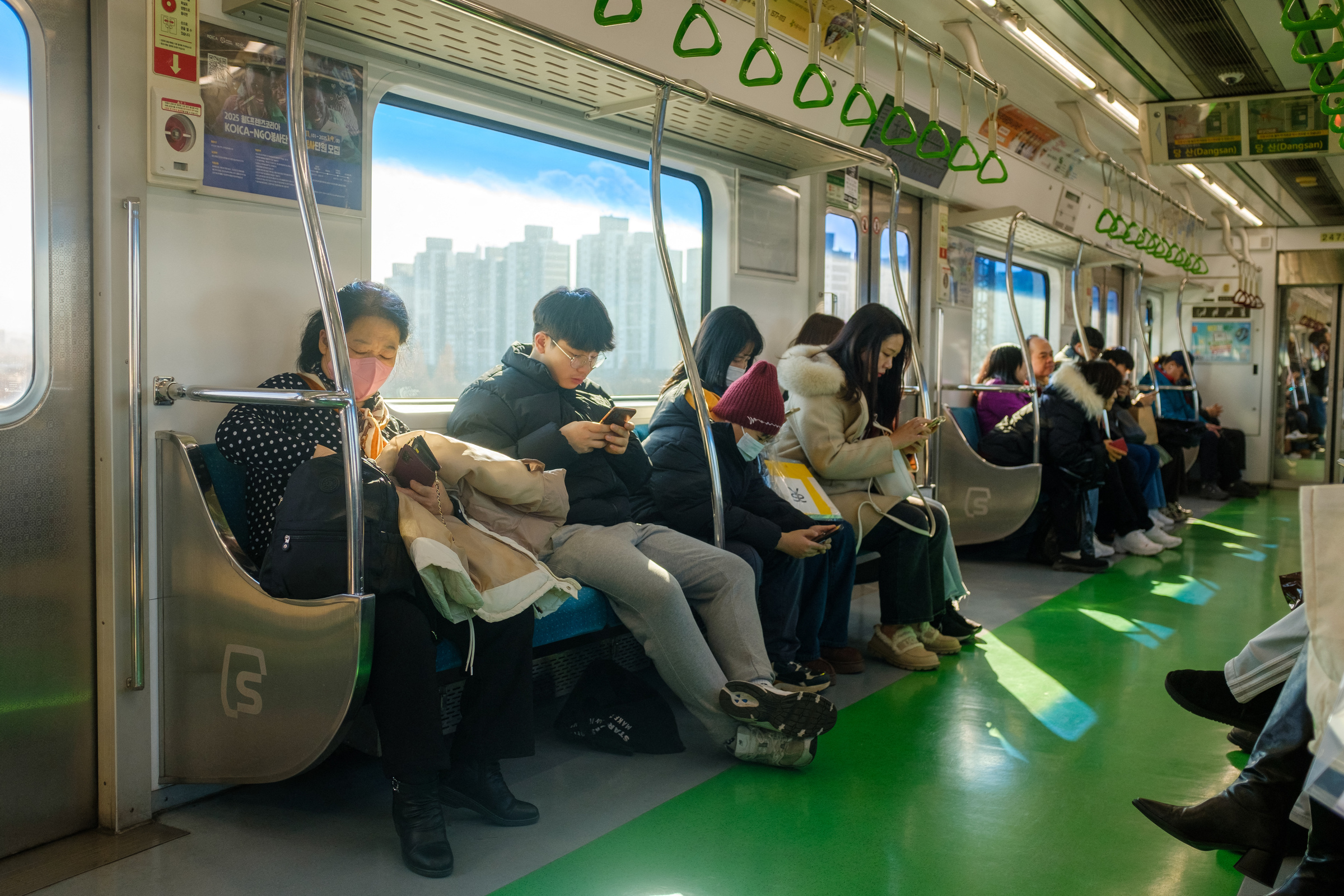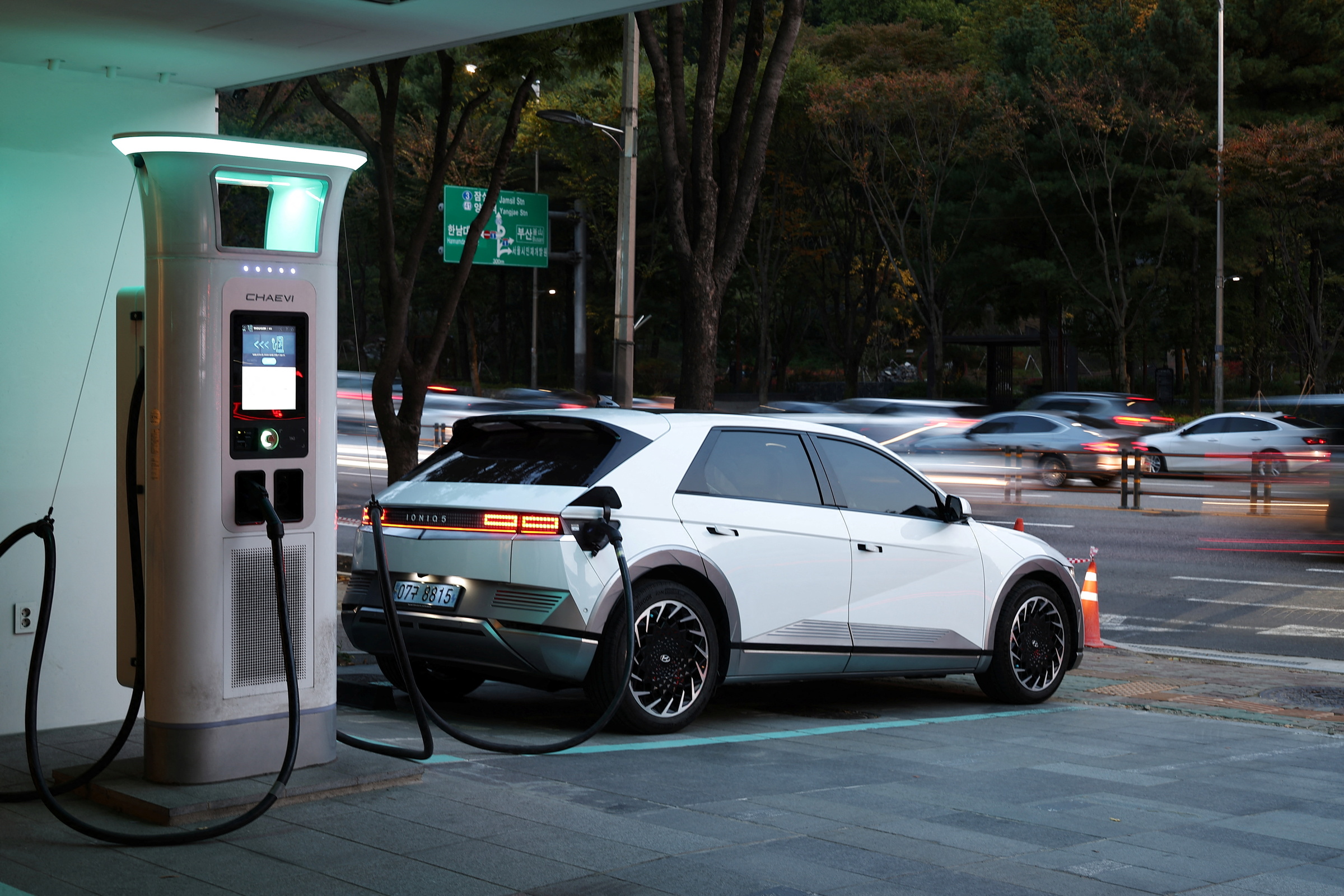Cities, the engines of global economic growth, generate over 80% of the world's GDP. These hubs of innovation and technological advancement play a vital role in job creation, trade, and social services.
However, this rapid development brings environmental challenges, demanding innovative solutions. Seoul, South Korea, stands out as a model with its "trial-and-error" approach to low-carbon urban transport, pursuing green and sustainable growth.
 |
South Koreans on a subway train in Seoul, 12/2024. Photo: AFP |
South Koreans on a subway train in Seoul, 12/2024. Photo: AFP
Seoul, with an inner-city population of around 10 million (nearly 20% of South Korea's total), spans 605 km2. Its population density exceeds 16,500 people/km2, placing it among the world's most densely populated areas.
Located near the 38th parallel, Seoul was devastated during the Korean War (1950-1953), with much of its infrastructure destroyed. Post-war, the city underwent rapid urbanization in the 1960s and 1970s.
The Seoul Metropolitan Government launched public housing projects, replacing infrastructure damaged in World War II, and accommodating a massive influx of migrants. However, transport and urban infrastructure development lagged behind population growth, leading to severe congestion, pollution, and informal settlements, according to research from the World Bank's Leadership in Urban Transport Planning (LUTP) program.
Initially, Seoul focused on road construction and urban renewal to address transportation needs and ease congestion, expanding development into new areas.
Major transport projects included the construction of subway lines 2 through 8, along with main roads and inner-city highways to connect the expanding urban areas.
Economic growth and rising incomes fueled a tenfold increase in car ownership from the 1980s to 2015. Initially, Seoul responded by expanding roads to meet infrastructure demands.
By the early 2000s, Seoul's approach shifted toward smart and sustainable urban management. This long-term process involved "trial-and-error" policies aimed at achieving these goals.
Seoul implemented policies to reduce private vehicle use and encourage public transport and eco-friendly alternatives.
A key project was the 2003 bus reform pilot in the northeastern city, introducing a semi-public bus system and dedicated bus lanes.
This project faced strong opposition. Bus companies feared losing profitable routes, drivers worried about job losses due to increased bus speeds, the Korean National Police raised safety concerns, and local residents feared impacts on businesses as bus stops moved from sidewalks to the middle of the road. Mayor Lee Myung-bak postponed the pilot from 7/2003 to 7/2004, acknowledging the importance of building public consensus.
The city then built consensus through a "Citizen's Bus Reform Committee" involving various groups.
The semi-public bus system was implemented, with the city managing routes and revenue, and private companies operating the buses. The T-Money smart card integrated bus and subway fares, and 115.3 km of dedicated bus lanes were built in the middle of roads.
This initiative increased average bus speeds by 30% and public transport usage to 65.1% by 2011 (28% buses, 37.1% subways), according to the Seoul Metropolitan Government's Department of Transportation.
During this period, the city also restored streams, parks, and public spaces in the old town. Digital transformation in administration and IT development addressed citizens' rising quality-of-life expectations.
A significant project was the demolition of the Cheonggye Expressway, built over the Cheonggyecheon stream. When the 30-year-old expressway failed a 2001 safety inspection, Seoul faced the choice of rebuilding or demolition.
Restoring the Cheonggyecheon stream became a key issue in that year's mayoral election. Lee Myung-bak's victory hinged on his pledge to demolish the expressway and restore the stream, enhancing Seoul's urban landscape and creating pedestrian spaces.
The city modeled the demolition's traffic impact and implemented mitigation measures: increased public transport access, reduced parking, increased parking fees, and real-time traffic information for diversion. The main goal was to reduce car use in the affected area.
The project's success is evident in traffic and environmental data. Pollution levels at Cheonggyecheon decreased significantly. The temperature at Cheonggyecheon, previously 2.2 degrees C higher than Seoul's average, dropped to 1.3 degrees C higher.
Seoul then launched the Nanum Car car-sharing program, partnering with private companies to provide gasoline and electric car rentals.
From 2013-2015, the program deployed 3,000 gasoline cars, reaching 72,600 users. Seoul also prepared for electric vehicles by building charging stations.
In 2014, Seoul installed 850 charging stations in parking lots, accommodating over 1,900 electric vehicles.
From 2016-2018, Nanum Car had 4,700 gasoline and electric vehicles, with users increasing to 210,000. From 2019-2022, rental cars reached 10,000, supported by dedicated parking spaces.
Seoul, and South Korea in general, are focusing on electric vehicles to achieve 2050 carbon neutrality, sustainable transport, and a "Smart City."
Besides infrastructure, Seoul partnered with the South Korean government to offer incentives for electric vehicle purchases: subsidies, tax breaks, reduced road tolls, and manufacturer support.
In 2022, Seoul aimed to replace 400,000 polluting combustion engine vehicles with electric vehicles by 2026. A Green Transport Zone restricts heavily polluting vehicles from the city center, and all new vehicle registrations from 2025 onward must be electric.
Electric vehicle infrastructure has also grown. In 2021, South Korea had over 94,000 charging stations, adding 100,000 annually.
The vehicle-to-charging station ratio decreased from 1.9 in 12/2023 to 1.7 in 1/2025, placing South Korea among the world's top electric vehicle adopters, surpassing markets like the US, Europe, and China, where one station serves around 10 vehicles.
According to the Korea Smart Grid Association, a non-profit promoting renewable energy, South Korea now has over 400,000 electric vehicle charging stations, with about 15% in Seoul.
 |
An electric vehicle at a charging station in Seoul, South Korea, 10/2023. Photo: Reuters |
An electric vehicle at a charging station in Seoul, South Korea, 10/2023. Photo: Reuters
South Korea aims for a charging station within a five-minute walk for everyone.
However, expanding electric vehicle infrastructure presents challenges in fire safety and infrastructure.
On 8/1/2024, an electric vehicle caught fire while charging in an underground parking lot, destroying 140 vehicles and damaging building systems. This incident raised public safety concerns, leading some buildings to ban electric vehicles from garages. Seoul then restricted electric vehicle charging to 90% in underground parking.
While more charging stations benefit electric vehicle users, they pose economic challenges for operators, requiring new policies from Seoul.
"As competition among charging station operators increases, turnover at each location will decrease," said Kim Seong-tae, head of the Korea Electric Vehicle Users Association. "This will lead to reduced revenue for some, making it difficult to repair damaged stations and pay electricity bills."
Nhu Tam (WB, C40 Cities, Korea Herald, KDI)












